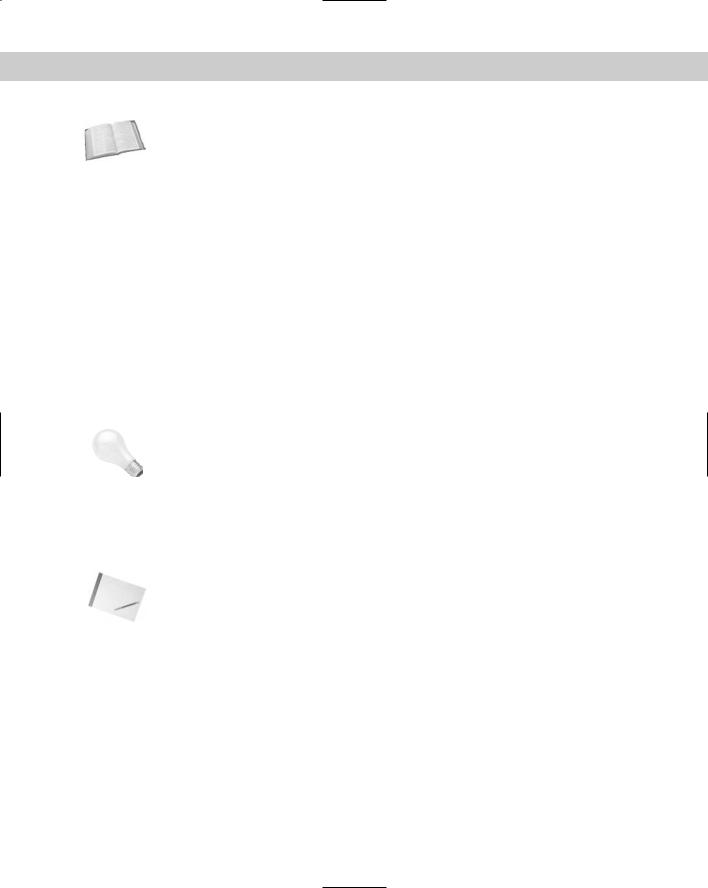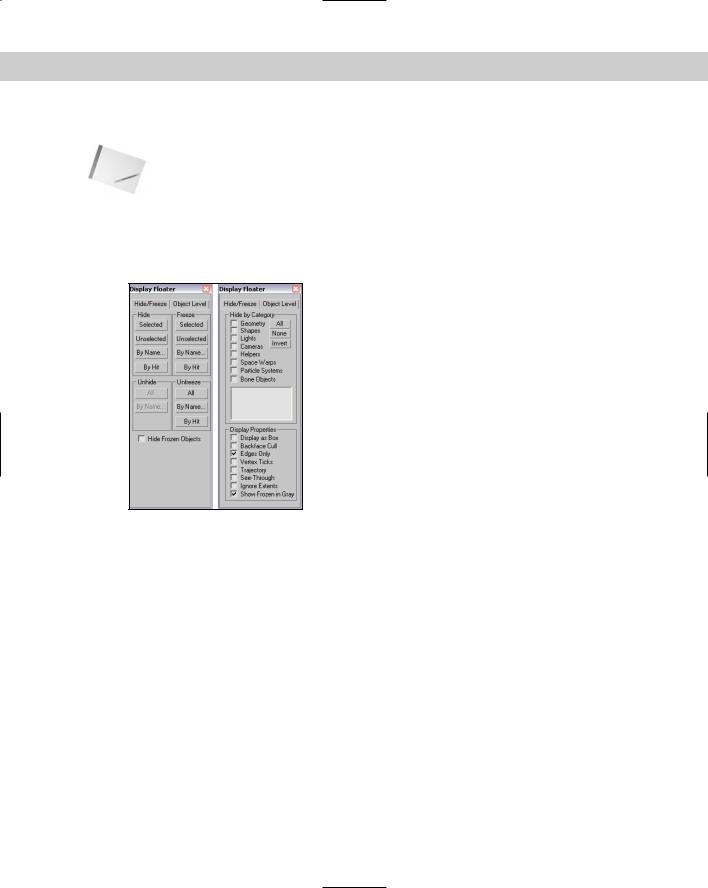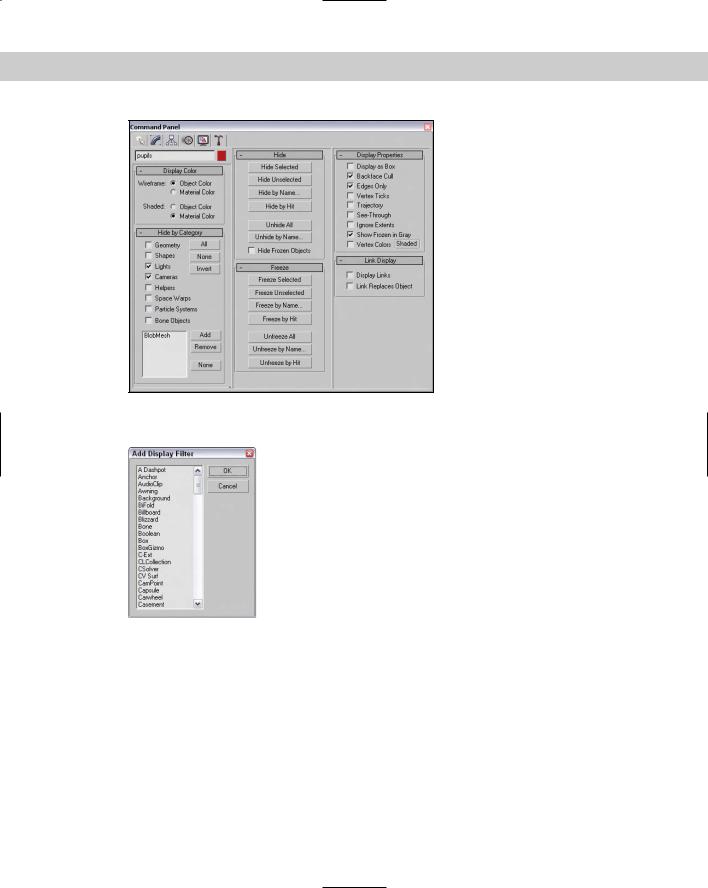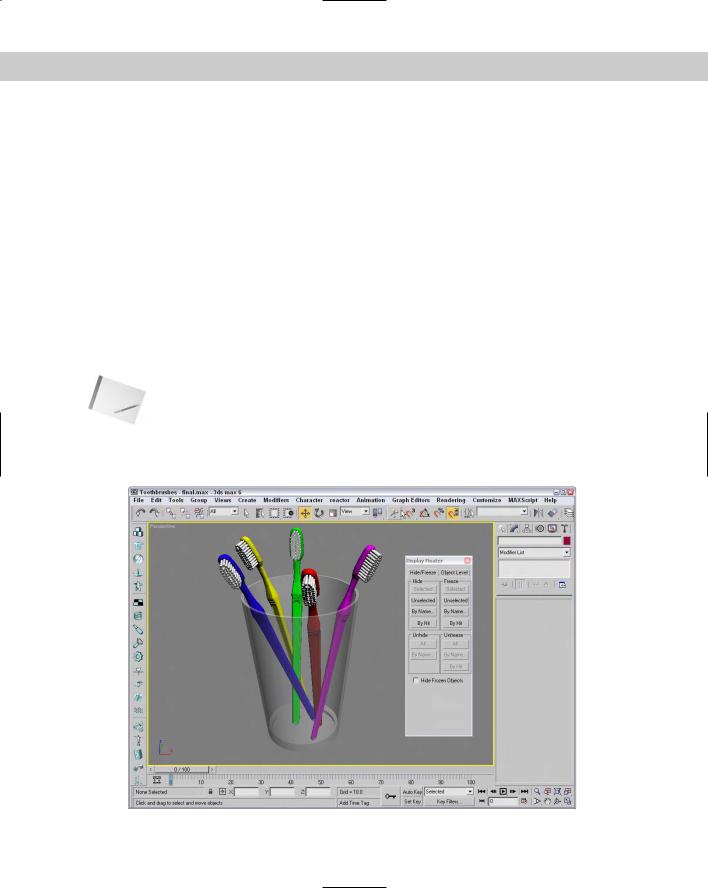
- •Preface
- •About This Book
- •Acknowledgments
- •Contents at a Glance
- •Contents
- •Relaxing at the Beach
- •Dressing the Scene
- •Animating Motion
- •Rendering the Final Animation
- •Summary
- •The Interface Elements
- •Using the Menus
- •Using the Toolbars
- •Using the Viewports
- •Using the Command Panel
- •Using the Lower Interface Bar Controls
- •Interacting with the Interface
- •Getting Help
- •Summary
- •Understanding 3D Space
- •Using the Viewport Navigation Controls
- •Configuring the Viewports
- •Working with Viewport Backgrounds
- •Summary
- •Working with Max Scene Files
- •Setting File Preferences
- •Importing and Exporting
- •Referencing External Objects
- •Using the File Utilities
- •Accessing File Information
- •Summary
- •Customizing Modify and Utility Panel Buttons
- •Working with Custom Interfaces
- •Configuring Paths
- •Selecting System Units
- •Setting Preferences
- •Summary
- •Creating Primitive Objects
- •Exploring the Primitive Object Types
- •Summary
- •Selecting Objects
- •Setting Object Properties
- •Hiding and Freezing Objects
- •Using Layers
- •Summary
- •Cloning Objects
- •Understanding Cloning Options
- •Mirroring Objects
- •Cloning over Time
- •Spacing Cloned Objects
- •Creating Arrays of Objects
- •Summary
- •Working with Groups
- •Building Assemblies
- •Building Links between Objects
- •Displaying Links and Hierarchies
- •Working with Linked Objects
- •Summary
- •Using the Schematic View Window
- •Working with Hierarchies
- •Setting Schematic View Preferences
- •Using List Views
- •Summary
- •Working with the Transformation Tools
- •Using Pivot Points
- •Using the Align Commands
- •Using Grids
- •Using Snap Options
- •Summary
- •Exploring the Modifier Stack
- •Exploring Modifier Types
- •Summary
- •Exploring the Modeling Types
- •Working with Subobjects
- •Modeling Helpers
- •Summary
- •Drawing in 2D
- •Editing Splines
- •Using Spline Modifiers
- •Summary
- •Creating Editable Mesh and Poly Objects
- •Editing Mesh Objects
- •Editing Poly Objects
- •Using Mesh Editing Modifiers
- •Summary
- •Introducing Patch Grids
- •Editing Patches
- •Using Modifiers on Patch Objects
- •Summary
- •Creating NURBS Curves and Surfaces
- •Editing NURBS
- •Working with NURBS
- •Summary
- •Morphing Objects
- •Creating Conform Objects
- •Creating a ShapeMerge Object
- •Creating a Terrain Object
- •Using the Mesher Object
- •Working with BlobMesh Objects
- •Creating a Scatter Object
- •Creating Connect Objects
- •Modeling with Boolean Objects
- •Creating a Loft Object
- •Summary
- •Understanding the Various Particle Systems
- •Creating a Particle System
- •Using the Spray and Snow Particle Systems
- •Using the Super Spray Particle System
- •Using the Blizzard Particle System
- •Using the PArray Particle System
- •Using the PCloud Particle System
- •Using Particle System Maps
- •Controlling Particles with Particle Flow
- •Summary
- •Understanding Material Properties
- •Working with the Material Editor
- •Using the Material/Map Browser
- •Using the Material/Map Navigator
- •Summary
- •Using the Standard Material
- •Using Shading Types
- •Accessing Other Parameters
- •Using External Tools
- •Summary
- •Using Compound Materials
- •Using Raytrace Materials
- •Using the Matte/Shadow Material
- •Using the DirectX 9 Shader
- •Applying Multiple Materials
- •Material Modifiers
- •Summary
- •Understanding Maps
- •Understanding Material Map Types
- •Using the Maps Rollout
- •Using the Map Path Utility
- •Using Map Instances
- •Summary
- •Mapping Modifiers
- •Using the Unwrap UVW modifier
- •Summary
- •Working with Cameras
- •Setting Camera Parameters
- •Summary
- •Using the Camera Tracker Utility
- •Summary
- •Using Multi-Pass Cameras
- •Creating Multi-Pass Camera Effects
- •Summary
- •Understanding the Basics of Lighting
- •Getting to Know the Light Types
- •Creating and Positioning Light Objects
- •Viewing a Scene from a Light
- •Altering Light Parameters
- •Working with Photometric Lights
- •Using the Sunlight and Daylight Systems
- •Using Volume Lights
- •Summary
- •Selecting Advanced Lighting
- •Using Local Advanced Lighting Settings
- •Tutorial: Excluding objects from light tracing
- •Summary
- •Understanding Radiosity
- •Using Local and Global Advanced Lighting Settings
- •Working with Advanced Lighting Materials
- •Using Lighting Analysis
- •Summary
- •Using the Time Controls
- •Working with Keys
- •Using the Track Bar
- •Viewing and Editing Key Values
- •Using the Motion Panel
- •Using Ghosting
- •Animating Objects
- •Working with Previews
- •Wiring Parameters
- •Animation Modifiers
- •Summary
- •Understanding Controller Types
- •Assigning Controllers
- •Setting Default Controllers
- •Examining the Various Controllers
- •Summary
- •Working with Expressions in Spinners
- •Understanding the Expression Controller Interface
- •Understanding Expression Elements
- •Using Expression Controllers
- •Summary
- •Learning the Track View Interface
- •Working with Keys
- •Editing Time
- •Editing Curves
- •Filtering Tracks
- •Working with Controllers
- •Synchronizing to a Sound Track
- •Summary
- •Understanding Your Character
- •Building Bodies
- •Summary
- •Building a Bones System
- •Using the Bone Tools
- •Using the Skin Modifier
- •Summary
- •Creating Characters
- •Working with Characters
- •Using Character Animation Techniques
- •Summary
- •Forward versus Inverse Kinematics
- •Creating an Inverse Kinematics System
- •Using the Various Inverse Kinematics Methods
- •Summary
- •Creating and Binding Space Warps
- •Understanding Space Warp Types
- •Combining Particle Systems with Space Warps
- •Summary
- •Understanding Dynamics
- •Using Dynamic Objects
- •Defining Dynamic Material Properties
- •Using Dynamic Space Warps
- •Using the Dynamics Utility
- •Using the Flex Modifier
- •Summary
- •Using reactor
- •Using reactor Collections
- •Creating reactor Objects
- •Calculating and Previewing a Simulation
- •Constraining Objects
- •reactor Troubleshooting
- •Summary
- •Understanding the Max Renderers
- •Previewing with ActiveShade
- •Render Parameters
- •Rendering Preferences
- •Creating VUE Files
- •Using the Rendered Frame Window
- •Using the RAM Player
- •Reviewing the Render Types
- •Using Command-Line Rendering
- •Creating Panoramic Images
- •Getting Printer Help
- •Creating an Environment
- •Summary
- •Creating Atmospheric Effects
- •Using the Fire Effect
- •Using the Fog Effect
- •Summary
- •Using Render Elements
- •Adding Render Effects
- •Creating Lens Effects
- •Using Other Render Effects
- •Summary
- •Using Raytrace Materials
- •Using a Raytrace Map
- •Enabling mental ray
- •Summary
- •Understanding Network Rendering
- •Network Requirements
- •Setting up a Network Rendering System
- •Starting the Network Rendering System
- •Configuring the Network Manager and Servers
- •Logging Errors
- •Using the Monitor
- •Setting up Batch Rendering
- •Summary
- •Compositing with Photoshop
- •Video Editing with Premiere
- •Video Compositing with After Effects
- •Introducing Combustion
- •Using Other Compositing Solutions
- •Summary
- •Completing Post-Production with the Video Post Interface
- •Working with Sequences
- •Adding and Editing Events
- •Working with Ranges
- •Working with Lens Effects Filters
- •Summary
- •What Is MAXScript?
- •MAXScript Tools
- •Setting MAXScript Preferences
- •Types of Scripts
- •Writing Your Own MAXScripts
- •Learning the Visual MAXScript Editor Interface
- •Laying Out a Rollout
- •Summary
- •Working with Plug-Ins
- •Locating Plug-Ins
- •Summary
- •Low-Res Modeling
- •Using Channels
- •Using Vertex Colors
- •Rendering to a Texture
- •Summary
- •Max and Architecture
- •Using AEC Objects
- •Using Architectural materials
- •Summary
- •Tutorial: Creating Icy Geometry with BlobMesh
- •Tutorial: Using Caustic Photons to Create a Disco Ball
- •Summary
- •mental ray Rendering System
- •Particle Flow
- •reactor 2.0
- •Schematic View
- •BlobMesh
- •Spline and Patch Features
- •Import and Export
- •Shell Modifier
- •Vertex Paint and Channel Info
- •Architectural Primitives and Materials
- •Minor Improvements
- •Choosing an Operating System
- •Hardware Requirements
- •Installing 3ds max 6
- •Authorizing the Software
- •Setting the Display Driver
- •Updating Max
- •Moving Max to Another Computer
- •Using Keyboard Shortcuts
- •Using the Hotkey Map
- •Main Interface Shortcuts
- •Dialog Box Shortcuts
- •Miscellaneous Shortcuts
- •System Requirements
- •Using the CDs with Windows
- •What’s on the CDs
- •Troubleshooting
- •Index

204 Part II Working with Objects
Cross- |
Advanced Lighting is covered in Chapter 28, “Advanced Lighting and Light Tracing,” and the |
Reference |
mental ray renderer is covered in Chapter 44, “Raytracing and mental ray.” |
|
Using the User-Defined panel
The User-Defined panel contains a simple text window. In this window, you can type any sort of information. This information is saved with the scene and can be referred to as notes about an object.
Hiding and Freezing Objects
|
Hidden and frozen objects cannot be selected, and as such they cannot be moved from their |
|
existing positions. This becomes convenient when you move objects around in the scene. If |
|
you have an object in a correct position, you can freeze it to prevent it from being moved |
|
accidentally or you can hide it from the viewports completely. A key difference between these |
|
modes is that frozen objects are still rendered, but hidden objects are not. |
|
You can hide and freeze objects in several ways. You can hide or freeze objects in a scene by |
|
selecting the Hide or Freeze options in the Object Properties dialog box. You can also hide |
|
and freeze objects using the Display Floater dialog box, which you access by choosing |
|
Tools Display Floater. |
Tip |
Several keyboard shortcuts can be used to hide specific objects. These shortcuts are toggles, |
|
so one press makes the objects disappear and another press makes them reappear. Object |
|
types that can be hidden with these shortcuts include cameras (Shift+C), geometry |
|
(Shift+G), grids (G), helpers (Shift+H), lights (Shift+L), particle systems (Shift+P), shapes |
|
(Shift+S), and Space Warps (Shift+W). |
|
The Hide option makes the selected object in the scene invisible, and the Freeze option turns |
|
the selected object dark gray (if the Show Frozen in Gray option in the Object Properties dia- |
|
log box is enabled) and doesn’t enable it to be transformed or selected. You cannot select |
|
hidden objects by clicking in the viewport. |
Note |
When you use the Zoom Extents button to resize the viewports around the current objects, |
|
hidden objects aren’t included. |
Using the Display Floater dialog box
The Display Floater dialog box includes two tabs: Hide/Freeze and Object Level. The Hide/ Freeze tab splits the dialog box into two columns, one for Hide and one for Freeze. Both columns have similar buttons that let you hide or freeze Selected or Unselected objects, By Name or By Hit. The By Name button opens the Select Objects dialog box (which is labeled Hide or Freeze Objects). The By Hit option lets you click in one of the viewports to select
an object to hide or freeze. Each column also has additional buttons to unhide or unfreeze All

Chapter 6 Selecting Objects and Setting Object Properties |
205 |
objects, By Name, or in the case of Freeze, By Hit. You can also select an option to Hide Frozen Objects.
Note Other places to find the same buttons found in the Display Floater are the Hide and Freeze rollouts of the Display panel of the Command Panel and in the right-click quadmenu.
The Object Level panel of the Display Floater lets you hide objects by category such as All Lights or Cameras. You can also view and change many of the Display Properties that are listed in the Object Properties dialog box.
Figure 6-11 shows the Hide/Freeze and Object Level panels of the Display Floater dialog box.
Figure 6-11: The Display Floater dialog box includes two panels: Hide/Freeze and Object Level.
Using the Display panel
If you were to take many of the features of the Display Floater and the Object Properties dialog box and mix them together with some new features, the result would be the Display panel. You access this panel by clicking the fifth icon from the left in the Command Panel (the icon that looks like monitor screen).
The first rollout in the Display panel, shown in Figure 6-12, is the Display Color rollout. This rollout includes options for setting whether Wireframe and Shaded objects in the viewports are displayed using the Object Color or the Material Color.
The panel also includes a Hide by Category rollout. Using this rollout, you can add new categories that will appear in the Object Level panel of the Display Floater. To add a new category, click the Add button of the Hide by Category rollout. The Add Display Filter list appears, as shown in Figure 6-13. From this list, you can choose specific object categories to add to the Hide by Category list.

206 Part II Working with Objects
Figure 6-12: The Display panel includes many of the same features of the Display Floater and Object Properties dialog box.
Figure 6-13: From this dialog box, you can add new categories to the Hide by Category list.
The Display panel also includes Hide and Freeze rollouts that include the same buttons and features as the Hide/Freeze panel of the Display Floater. You also find a Display Properties rollout that is the same as the list found in the Display Floater’s Object Level panel and the Object Properties dialog box.
The Link Display rollout at the bottom of the Display panel includes options for displaying links in the viewports. Links are displayed as lines that extend from the child to its parent object. Using the Link Replaces Object option, you can hide the objects in the viewport and see only the links.

Chapter 6 Selecting Objects and Setting Object Properties |
207 |
Tutorial: Hidden toothbrushes
In this example, I’ve hidden several toothbrushes in the scene and your task is to find them. To find the hidden objects, follow these steps:
1.Open the Toothbrushes.max scene file.
This file appears to only contain a single toothbrush, but there are more. See if you can find them. The toothbrush model was created by Viewpoint Datalabs. You can find it in the Chap 06 directory on the CD-ROM.
2.Locate the hidden object in the scene by opening the Display Floater (choose Tools Display Floater).
3.In the Display Floater, select the Hide/Freeze tab. In the Unhide section, click the Name button.
The Unhide Objects dialog box appears, which lists all the hidden objects in the scene.
4.Select the green toothbrush object from the list, and click the Unhide button.
The Unhide Objects dialog box closes, and the hidden objects become visible again.
Note Notice that the Display Floater is still open. That’s because it’s modeless. You don’t need to close it in order to keep working.
5. To see all the remaining objects, click the Unhide All button in the Display Floater.
Figure 6-14 shows the finished scene with all toothbrushes visible.
Figure 6-14: Toothbrushes for the whole family; just remember which color is yours.
